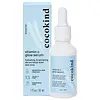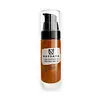What's inside
What's inside
 Key Ingredients
Key Ingredients

 Benefits
Benefits

 Concerns
Concerns

No concerns
 Ingredients Side-by-side
Ingredients Side-by-side

Aloe Barbadensis Leaf Juice
Skin ConditioningWater
Skin ConditioningGlycerin
HumectantPolyglycerin-6
HumectantPentylene Glycol
Skin ConditioningAscorbyl Glucoside
AntioxidantAzelaic Acid
BufferingPropanediol
SolventXanthan Gum
EmulsifyingCaprylyl Glyceryl Ether
CleansingSodium Hydroxide
BufferingSodium Citrate
BufferingBetaine
HumectantCaulerpa Lentillifera Extract
Caprylhydroxamic Acid
Sodium Hyaluronate
HumectantSodium Phytate
Sodium Benzoate
MaskingCitric Acid
BufferingAloe Barbadensis Leaf Juice, Water, Glycerin, Polyglycerin-6, Pentylene Glycol, Ascorbyl Glucoside, Azelaic Acid, Propanediol, Xanthan Gum, Caprylyl Glyceryl Ether, Sodium Hydroxide, Sodium Citrate, Betaine, Caulerpa Lentillifera Extract, Caprylhydroxamic Acid, Sodium Hyaluronate, Sodium Phytate, Sodium Benzoate, Citric Acid
Aloe Barbadensis Leaf Juice
Skin ConditioningWater
Skin ConditioningNiacinamide 3%
SmoothingGlycerin
HumectantAspalathus Linearis Leaf Extract 1.3%
Skin ConditioningCitric Acid
BufferingLysolecithin
EmulsifyingSclerotium Gum
Emulsion StabilisingCannabis Sativa Seed Oil
EmollientSodium Benzoate
MaskingPullulan
Xanthan Gum
EmulsifyingCentella Asiatica Leaf Extract
Skin ConditioningSodium Hyaluronate
HumectantAdansonia Digitata Seed Oil
EmollientPotassium Sorbate
PreservativeTocopherol
AntioxidantArgania Spinosa Kernel Oil
EmollientSodium Phytate
Ubiquinone
AntioxidantGlycine Soja Oil
EmollientSilica
AbrasiveHydroxypropyl Cyclodextrin
MaskingHippophae Rhamnoides Fruit Extract
Skin ConditioningCurcuma Longa Root Extract
MaskingChlorella Vulgaris Powder
Skin ConditioningTetrahydropiperine
Skin ConditioningGlycyrrhiza Glabra Root Extract
BleachingCalendula Officinalis Flower Extract
MaskingPalmitoyl Tripeptide-38
Skin ConditioningAloe Barbadensis Leaf Juice, Water, Niacinamide 3%, Glycerin, Aspalathus Linearis Leaf Extract 1.3%, Citric Acid, Lysolecithin, Sclerotium Gum, Cannabis Sativa Seed Oil, Sodium Benzoate, Pullulan, Xanthan Gum, Centella Asiatica Leaf Extract, Sodium Hyaluronate, Adansonia Digitata Seed Oil, Potassium Sorbate, Tocopherol, Argania Spinosa Kernel Oil, Sodium Phytate, Ubiquinone, Glycine Soja Oil, Silica, Hydroxypropyl Cyclodextrin, Hippophae Rhamnoides Fruit Extract, Curcuma Longa Root Extract, Chlorella Vulgaris Powder, Tetrahydropiperine, Glycyrrhiza Glabra Root Extract, Calendula Officinalis Flower Extract, Palmitoyl Tripeptide-38
 Reviews
Reviews

Ingredients Explained
These ingredients are found in both products.
Ingredients higher up in an ingredient list are typically present in a larger amount.
Aloe Barbadensis Leaf Juice comes from leaves of the aloe plant. Aloe Barbadensis Leaf Juice is best known for helping to soothe sunburns. It is also anti-inflammatory, moisturizing, antiseptic, and can help heal wounds.
Aloe is packed with good stuff including Vitamins A, C, and E. These vitamins are antioxidants, which help fight free-radicals and the damage they may cause. Free-radicals are molecules that may damage your skin cells, such as pollution.
Aloe Barbadensis Leaf Juice also contains sugars. These sugars come in the form of monosaccharides and polysaccharides, folic acid, and choline. These sugars are able to help bind moisture to skin.
It also contains minerals such as calcium, 12 anthraquinones, fatty acids, amino acids, and Vitamin B12.
Learn more about Aloe Barbadensis Leaf JuiceCitric Acid is an alpha hydroxy acid (AHA) naturally found in citrus fruits like oranges, lemons, and limes.
Like other AHAs, citric acid can exfoliate skin by breaking down the bonds that hold dead skin cells together. This helps reveal smoother and brighter skin underneath.
However, this exfoliating effect only happens at high concentrations (20%) which can be hard to find in cosmetic products.
Due to this, citric acid is usually included in small amounts as a pH adjuster. This helps keep products slightly more acidic and compatible with skin's natural pH.
In skincare formulas, citric acid can:
While it can provide some skin benefits, research shows lactic acid and glycolic acid are generally more effective and less irritating exfoliants.
Most citric acid used in skincare today is made by fermenting sugars (usually from molasses). This synthetic version is identical to the natural citrus form but easier to stabilize and use in formulations.
Read more about some other popular AHA's here:
Learn more about Citric AcidGlycerin is already naturally found in your skin. It helps moisturize and protect your skin.
A study from 2016 found glycerin to be more effective as a humectant than AHAs and hyaluronic acid.
As a humectant, it helps the skin stay hydrated by pulling moisture to your skin. The low molecular weight of glycerin allows it to pull moisture into the deeper layers of your skin.
Hydrated skin improves your skin barrier; Your skin barrier helps protect against irritants and bacteria.
Glycerin has also been found to have antimicrobial and antiviral properties. Due to these properties, glycerin is often used in wound and burn treatments.
In cosmetics, glycerin is usually derived from plants such as soybean or palm. However, it can also be sourced from animals, such as tallow or animal fat.
This ingredient is organic, colorless, odorless, and non-toxic.
Glycerin is the name for this ingredient in American English. British English uses Glycerol/Glycerine.
Learn more about GlycerinSodium Benzoate is a preservative. It's used in both cosmetic and food products to inhibit the growth of mold and bacteria. It is typically produced synthetically.
Both the US FDA and EU Health Committee have approved the use of sodium benzoate. In the US, levels of 0.1% (of the total product) are allowed.
Sodium benzoate works as a preservative by inhibiting the growth of bacteria inside of cells. It prevents the cell from fermenting a type of sugar using an enzyme called phosphofructokinase.
It is the salt of benzoic acid. Foods containing sodium benzoate include soda, salad dressings, condiments, fruit juices, wines, and snack foods.
Studies for using ascorbic acid and sodium benzoate in cosmetics are lacking, especially in skincare routines with multiple steps.
We always recommend speaking with a professional, such as a dermatologist, if you have any concerns.
Learn more about Sodium BenzoateSodium Hyaluronate is hyaluronic acid's salt form. It is commonly derived from the sodium salt of hyaluronic acid.
Like hyaluronic acid, it is great at holding water and acts as a humectant. This makes it a great skin hydrating ingredient.
Sodium Hyaluronate is naturally occurring in our bodies and is mostly found in eye fluid and joints.
These are some other common types of Hyaluronic Acid:
Learn more about Sodium HyaluronateSodium Phytate is the synthetic salt form of phytic acid. Phytic acid is an antioxidant and can be found in plant seeds.
Sodium Phytate is a chelating agent. Chelating agents help prevent metals from binding to water. This helps stabilize the ingredients and the product.
Water. It's the most common cosmetic ingredient of all. You'll usually see it at the top of ingredient lists, meaning that it makes up the largest part of the product.
So why is it so popular? Water most often acts as a solvent - this means that it helps dissolve other ingredients into the formulation.
You'll also recognize water as that liquid we all need to stay alive. If you see this, drink a glass of water. Stay hydrated!
Learn more about WaterXanthan gum is used as a stabilizer and thickener within cosmetic products. It helps give products a sticky, thick feeling - preventing them from being too runny.
On the technical side of things, xanthan gum is a polysaccharide - a combination consisting of multiple sugar molecules bonded together.
Xanthan gum is a pretty common and great ingredient. It is a natural, non-toxic, non-irritating ingredient that is also commonly used in food products.
Learn more about Xanthan Gum